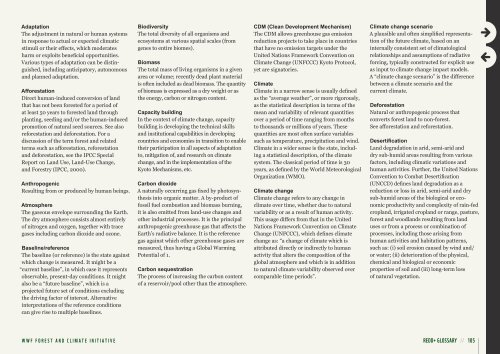WWF Guide to Building REDD+ Strategies
WWF Guide to Building REDD+ Strategies
WWF Guide to Building REDD+ Strategies
You also want an ePaper? Increase the reach of your titles
YUMPU automatically turns print PDFs into web optimized ePapers that Google loves.
Adaptation<br />
The adjustment in natural or human systems<br />
in response <strong>to</strong> actual or expected climatic<br />
stimuli or their effects, which moderates<br />
harm or exploits beneficial opportunities.<br />
Various types of adaptation can be distinguished,<br />
including anticipa<strong>to</strong>ry, au<strong>to</strong>nomous<br />
and planned adaptation.<br />
Afforestation<br />
Direct human-induced conversion of land<br />
that has not been forested for a period of<br />
at least 50 years <strong>to</strong> forested land through<br />
planting, seeding and/or the human-induced<br />
promotion of natural seed sources. See also<br />
reforestation and deforestation. For a<br />
discussion of the term forest and related<br />
terms such as afforestation, reforestation<br />
and deforestation, see the IPCC Special<br />
Report on Land Use, Land-Use Change,<br />
and Forestry (IPCC, 2000).<br />
Anthropogenic<br />
Resulting from or produced by human beings.<br />
Atmosphere<br />
The gaseous envelope surrounding the Earth.<br />
The dry atmosphere consists almost entirely<br />
of nitrogen and oxygen, <strong>to</strong>gether with trace<br />
gases including carbon dioxide and ozone.<br />
Baseline/reference<br />
The baseline (or reference) is the state against<br />
which change is measured. It might be a<br />
“current baseline”, in which case it represents<br />
observable, present-day conditions. It might<br />
also be a “future baseline”, which is a<br />
projected future set of conditions excluding<br />
the driving fac<strong>to</strong>r of interest. Alternative<br />
interpretations of the reference conditions<br />
can give rise <strong>to</strong> multiple baselines.<br />
<strong>WWF</strong> FOREST AND CLIMATE INITIATIVE<br />
Biodiversity<br />
The <strong>to</strong>tal diversity of all organisms and<br />
ecosystems at various spatial scales (from<br />
genes <strong>to</strong> entire biomes).<br />
Biomass<br />
The <strong>to</strong>tal mass of living organisms in a given<br />
area or volume; recently dead plant material<br />
is often included as dead biomass. The quantity<br />
of biomass is expressed as a dry weight or as<br />
the energy, carbon or nitrogen content.<br />
Capacity building<br />
In the context of climate change, capacity<br />
building is developing the technical skills<br />
and institutional capabilities in developing<br />
countries and economies in transition <strong>to</strong> enable<br />
their participation in all aspects of adaptation<br />
<strong>to</strong>, mitigation of, and research on climate<br />
change, and in the implementation of the<br />
Kyo<strong>to</strong> Mechanisms, etc.<br />
Carbon dioxide<br />
A naturally occurring gas fixed by pho<strong>to</strong>synthesis<br />
in<strong>to</strong> organic matter. A by-product of<br />
fossil fuel combustion and biomass burning,<br />
it is also emitted from land-use changes and<br />
other industrial processes. It is the principal<br />
anthropogenic greenhouse gas that affects the<br />
Earth’s radiative balance. It is the reference<br />
gas against which other greenhouse gases are<br />
measured, thus having a Global Warming<br />
Potential of 1.<br />
Carbon sequestration<br />
The process of increasing the carbon content<br />
of a reservoir/pool other than the atmosphere.<br />
CDM (Clean Development Mechanism)<br />
The CDM allows greenhouse gas emission<br />
reduction projects <strong>to</strong> take place in countries<br />
that have no emission targets under the<br />
United Nations Framework Convention on<br />
Climate Change (UNFCCC) Kyo<strong>to</strong> Pro<strong>to</strong>col,<br />
yet are signa<strong>to</strong>ries.<br />
Climate<br />
Climate in a narrow sense is usually defined<br />
as the “average weather”, or more rigorously,<br />
as the statistical description in terms of the<br />
mean and variability of relevant quantities<br />
over a period of time ranging from months<br />
<strong>to</strong> thousands or millions of years. These<br />
quantities are most often surface variables<br />
such as temperature, precipitation and wind.<br />
Climate in a wider sense is the state, including<br />
a statistical description, of the climate<br />
system. The classical period of time is 30<br />
years, as defined by the World Meteorological<br />
Organization (WMO).<br />
Climate change<br />
Climate change refers <strong>to</strong> any change in<br />
climate over time, whether due <strong>to</strong> natural<br />
variability or as a result of human activity.<br />
This usage differs from that in the United<br />
Nations Framework Convention on Climate<br />
Change (UNFCCC), which defines climate<br />
change as: “a change of climate which is<br />
attributed directly or indirectly <strong>to</strong> human<br />
activity that alters the composition of the<br />
global atmosphere and which is in addition<br />
<strong>to</strong> natural climate variability observed over<br />
comparable time periods”.<br />
Climate change scenario<br />
A plausible and often simplified representation<br />
of the future climate, based on an<br />
internally consistent set of clima<strong>to</strong>logical<br />
relationships and assumptions of radiative<br />
forcing, typically constructed for explicit use<br />
as input <strong>to</strong> climate change impact models.<br />
A “climate change scenario” is the difference<br />
between a climate scenario and the<br />
current climate.<br />
Deforestation<br />
Natural or anthropogenic process that<br />
converts forest land <strong>to</strong> non-forest.<br />
See afforestation and reforestation.<br />
Desertification<br />
Land degradation in arid, semi-arid and<br />
dry sub-humid areas resulting from various<br />
fac<strong>to</strong>rs, including climatic variations and<br />
human activities. Further, the United Nations<br />
Convention <strong>to</strong> Combat Desertification<br />
(UNCCD) defines land degradation as a<br />
reduction or loss in arid, semi-arid and dry<br />
sub-humid areas of the biological or economic<br />
productivity and complexity of rain-fed<br />
cropland, irrigated cropland or range, pasture,<br />
forest and woodlands resulting from land<br />
uses or from a process or combination of<br />
processes, including those arising from<br />
human activities and habitation patterns,<br />
such as: (i) soil erosion caused by wind and/<br />
or water; (ii) deterioration of the physical,<br />
chemical and biological or economic<br />
properties of soil and (iii) long-term loss<br />
of natural vegetation.<br />
Redd+ GloSSaRy // 105

















